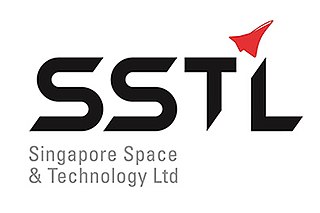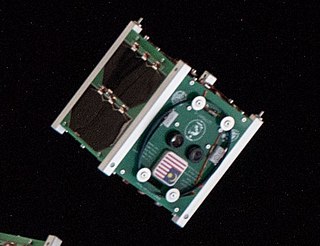Related Research Articles

The Japanese Experiment Module (JEM), nicknamed Kibō, is a Japanese science module for the International Space Station (ISS) developed by JAXA. It is the largest single ISS module, and is attached to the Harmony module. The first two pieces of the module were launched on Space Shuttle missions STS-123 and STS-124. The third and final components were launched on STS-127.

The Japan Aerospace Exploration Agency (JAXA) is the Japanese national air and space agency. Through the merger of three previously independent organizations, JAXA was formed on 1 October 2003. JAXA is responsible for research, technology development and launch of satellites into orbit, and is involved in many more advanced missions such as asteroid exploration and possible human exploration of the Moon. Its motto is One JAXA and its corporate slogan is Explore to Realize.
Technology Education Satellite (TechEdSat) is a successful nano-sat flight series conducted from the NASA Ames Research Center in collaboration with numerous universities. While one of the principal aims has been to introduce young professionals and university students to the practical realm of developing space flight hardware, considerable innovations have been introduced. In addition, this evolving flight platform has tested concepts for Low Earth Orbit (LEO) sample return, as well as planetary nano-sat class mission concepts.

Kounotori 3, also known as HTV-3, was the third flight of the Japanese H-II Transfer Vehicle. It was launched on 21 July 2012 to resupply the International Space Station (ISS) aboard the H-IIB Launch Vehicle No. 3 manufactured by Mitsubishi Heavy Industries (MHI) and JAXA. Kounotori 3 arrived at the ISS on 27 July 2012, and Expedition 32 Flight Engineer and JAXA astronaut Akihiko Hoshide used the International Space Station's Canadarm2 robotic arm to install Kounotori 3, to its docking port on the Earth-facing side (nadir) of the Harmony module at 14:34 UTC.
TurkSat-3USat is a Turkish communications nanosatellite developed by the Space Systems Design and Test Laboratory and Radio Frequency Electronics Laboratory of Istanbul Technical University (ITU) in collaboration with the Türksat company along with Turkish Amateur Satellite Technology Organization (TAMSAT). It was launched on 26 April 2013.

The Nanoracks CubeSat Deployer (NRCSD) is a device to deploy CubeSats into orbit from the International Space Station (ISS).

AESP-14 is a Brazilian 1U Cubesat developed by multiple Brazilian institutions. It was launched on 10 January 2015 aboard the SpaceX CRS-5 mission on a Falcon 9 v1.1 rocket. It was the first Brazilian Cubesat ever launched into space.

GhanaSat-1 was the first Ghanaian nanosatellite to be launched into space. It was designed and built in two years in conjunction with the Kyushu Institute of Technology Birds-1 program, which has the goal of helping countries build their first satellite.

BRAC Onnesha was the first nanosatellite built in Bangladesh to be launched into space. The satellite was designed and built in conjunction with Kyushu Institute of Technology Birds-1 program, which has the goal of helping countries build their first satellite. It was designed and built over a two-year period.

Birds-1 was the first iteration of a multinational program called the Joint Global Multi-Nations Birds Satellite project, or Birds project, to help countries build their first satellite. The Japanese Kyushu Institute of Technology (KIT) supported the design and fabrication of the satellites. The constellation was launched by a Falcon 9 rocket to the International Space Station on 3 June 2017, as part of CRS-11, where it was released from the Kibō module into space. Japan, Ghana, Mongolia, Nigeria, and Bangladesh participated in the Birds-1 program, all building identical satellites for the constellation.

1KUNS-PF was the first Kenyan-owned satellite. The cubesat was developed and assembled by the University of Nairobi for the Kenya Space Agency, with technical support provided by Japan's Aerospace Exploration Agency. The spacecraft was deployed from the International Space Station are being launched by a SpaceX Falcon 9 rocket.
Irazú was the first Costa Rican satellite to be launched into space. The nanosatellite was launched into space on 2 April 2018, on board a Falcon 9 rocket headed for the International Space Station. It was expected to orbit the Earth for six months with the function of monitoring carbon, humidity, and temperature levels in Costa Rican forests. Funds for the launch of satellite were provided, in a significant part, through a Kickstarter crowdfunding campaign.

BHUTAN-1 was the first Bhutanese nanosatellite to be launched into space. The satellite was built during Kyushu Institute of Technology's Birds-2 program. The Birds program helps countries fly their first satellite. BHUTAN-1 was launched into orbit aboard the SpaceX CRS-15 mission on 29 June 2018. It was deployed from the Kibō module of the International Space Station (ISS) on 10 August 2018. The satellite had cameras to image the Earth.

Singapore Space and Technology Ltd (SSTL) is a non-governmental space organization based in Singapore within the aerospace industry. SSTL is recognized by the International Astronautical Federation.

UiTMSAT-1 was a Malaysian nanosatellite, built primarily by Universiti Teknologi MARA (UiTM) as part of the multi-nation Birds-2 project. The 1U CubeSat was launched into space on 29 June 2018 and deployed from the International Space Station (ISS) on 10 August 2018.

Birds-2 is the second iteration of a multinational program called the Joint Global Multi-Nations Birds Satellite project, or Birds project, to help countries build their first satellite. The Japanese Kyushu Institute of Technology (KIT) supported the design and fabrication of the satellites. The satellites were launched by the Falcon 9 Full Thrust rocket as a part of the SpaceX CRS-15 mission on 29 June 2018. The satellites were released from the Kibō module of the International Space Station (ISS) in August 2018.
AQT-D was a nanosatellite project of the University of Tokyo (UT) Space Propulsion Laboratory with the purpose of testing water-fueled propulsion. The satellite was a CubeSat of 3U size; 1U was occupied by the propulsion system, while the remaining 2U was for the spacecraft bus. AQT-D was carried to space inside the pressurized section of Kounotori 8, a Japanese resupply vehicle for the International Space Station (ISS). Kounotori 8 was launched on 24 September 2019. After arriving at the ISS, AQT-D was deployed to space on 20 November 2019 using the JEMRMS robotic arm at the space station's Kibō laboratory module.
Maya-2 was a Filipino nanosatellite. It succeeded Maya-1, the first Filipino nanosatellite, which was deorbited in November 2020.
TUMnanoSAT was a nanosatellite and the first artificial satellite made by Moldova. It was built by the Technical University of Moldova (UTM) and was launched on 15 July 2022. SpaceX's Falcon 9 rocket carried TUMnanoSAT to the International Space Station (ISS). This was through the SpaceX CRS-25 Commercial Resupply Service mission. In this mission, Falcon 9 carried a SpaceX Dragon 2 spacecraft which contained the J-SSOD launch capsule of the Japan Aerospace Exploration Agency (JAXA) within which in turn was TUMnanoSAT. The satellite project and its launch was carried out in cooperation with the JAXA and the United Nations Office for Outer Space Affairs (UNOOSA) as part of the KiboCUBE program. Once brought to the ISS, TUMnanoSAT was put into orbit from there on 12 August.
References
- ↑ "Celestrak". celestrak.com. Retrieved 2020-07-27.
- ↑ Rupprecht, Mike. "UBAKUSAT - Amateur Radio". dk3wn.info. Archived from the original on 2020-07-27. Retrieved 2020-07-27.
- ↑ "UBAKUSAT". N2YO.com. 27 December 2020. Retrieved 9 December 2021.
- ↑ ÜNİVERSİTESİ, İSTANBUL TEKNİK. ""UBAKUSAT Kupsat" Satellite developed by ITU Prepares for Launch". www.itu.edu.tr. Istanbul Technical University. Archived from the original on 2018-05-21. Retrieved 2018-05-21.
- 1 2 3 4 5 "Chinese, Turkish Amateur Radio Satellites Near Launch Dates". www.arrl.org. American Radio Relay League . Retrieved 2018-05-30.
- ↑ "Ülkemizin Uzaya gönderilen Uydusu UBAKUSAT İTÜ'den – USTTL". usttl.itu.edu.tr (in Turkish). 10 May 2018. Retrieved 2018-05-30.
- ↑ "Annual Meetings | APRSAF-24". www.aprsaf.org. Asia-Pacific Regional Space Agency Forum. Retrieved 2018-05-30.
- ↑ "Turkey's ambitious space venture set to start next month". DailySabah. Retrieved 2018-05-30.
- 1 2 "The Republic of Turkey hands over its CubeSat "UBAKUSAT" to Japan. Launch preparation starts. Scheduled to be deployment during Astronaut Kanai stay onboard!:Experiment – International Space Station". Japan Aerospace Exploration Agency . Retrieved 2018-05-21.
- 1 2 "Kenya's first satellite released from Japan's Kibo module at ISS". The Japan Times Online. 2018-05-12. ISSN 0447-5763. Archived from the original on 2018-05-17. Retrieved 2018-05-17.